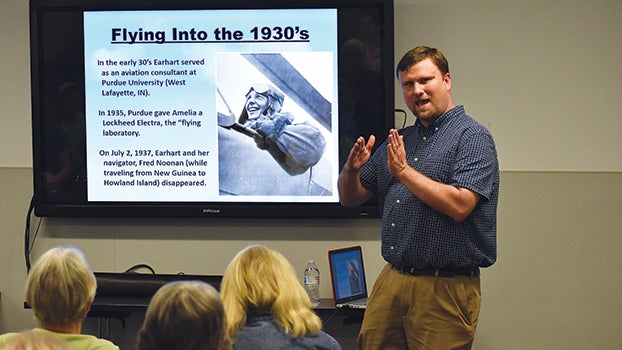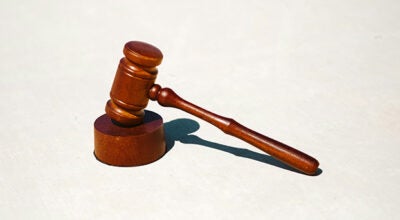What happened to Amelia Earhart?
Published 9:41 am Monday, April 29, 2019

- Jason Kuntz leads a lecture on Amelia Earhart Thursday night at the Niles District Library. (Leader photo/KELSEY HAMMON)
NILES — Amelia Earhart defied more than earthly boundaries when she became a record-shattering pilot.
As the first woman to complete solo missions over the Atlantic and from Hawaii to the U.S. Mainland, Earhart’s work challenged traditional women’s roles of the era and broke ground on a whole new frontier: the sky. More than 80 years after her disappearance, little is known about what went wrong during Earhart’s final mission to circumnavigate the world.
During a presentation on the pilot Thursday night at the Niles District Library, Jason Kuntz, a Three Oaks Elementary teacher and history buff, shared a bit about Earhart’s life and speculated on what happened to her on that fateful final journey.
“I think there’s a whole lot more to Earhart’s story than what we have been told,” Kuntz said. “She was a celebrity, but she did not walk on red carpets. She just did something she was passionate about and died doing what she loved. I think that is something to be very admired.”
The presentation took place as part of the library’s Spring Local History series. The lectures have been free and open to the public. The presentation on Earhart drew approximately 20 people to listen to Kuntz’s talk.
Kuntz began by discussing a bit about Earhart’s early life.
Earhart was born July 24, 1897, in Atchison, Kansas. To pay for flying lessons, Earhart had to work several odd jobs. She picked up work shifts as a truck driver and a photographer, among other jobs. Earhart’s legacy in the sky was aided by other women who also shared a passion for flight. In 1921, she started taking lessons from female flight instructor Neta Snook. That same year, Earhart purchased her first plane, a bright-yellow Kinner Airster that she named the Yellow Canary.
Kuntz marveled at the bravery it must have taken to fly in a time when the technology was still considered to be in its infancy. It was only 18 years before in 1903 that Orville and William Wright had sustained a 12-second flight, marking the airborne plane in America.
“You’ve got to admire the determination and courage it took to go forward with all of this,” Kuntz said.
Earhart would go on to become a national celebrity. Another feat Kuntz said is impressive, due to the fact that she was well known despite a lack of internet and social media. Her fame was jet-setted by a 1928 solo flight from Newfoundland, Canada to Wales.
Earhart would establish connections throughout the Midwest. She studied at a high school in Chicago. In the 1930s, she served as an aviation consultant at Purdue University in West Lafayette, Indiana. In 1935, the university gave her the Lockheed Electra — a plane harkened as a flying laboratory.
On May 21, 1937, Earhart climbed aboard a plane with navigator Fred Noonan to attempt a round-the-world flight, starting in Oakland, California. The pair were last seen in New Guinea on July 2 of that year. There has been only speculation as to what happened on that flight. Earhart and Noonan have not been found. Some believe that she might have crashed into the ocean.
Kuntz had another theory. He said there had been some indication that Earhart could have been sent by President Franklin Roosevelt to spy on the Marshall Islands and captured by Japanese troops.
While Kuntz said he was not sure that Earhart was ever a spy, he does believe Earhart and Noonan might have crashed somewhere in the Marshall Islands, which were under Japanese occupation. He said there had been reports from island residents who supposedly knew of Earhart.
“How is that possible? There was no internet or much communication with the outside world,” Kuntz said.
While both radio and TV had been invented, Kuntz believes it is doubtful Marshall Island residents would have known about Earhart unless they had come into contact with her.
“The Marshall Islanders, nor anyone in that part of the world, knew who Amelia Earhart was,” Kuntz said. “She was only a celebrity in the continental U.S.”
Kuntz said there were some claims that people on the Marshall Islands had seen Earhart and Noonan taken aboard a Japanese Battle Ship and that a doctor supposedly treated Noonan for a broken leg.
In the 1930s, pre-World War II conflict was reaching a boiling point. Kuntz said some theories suggest that after their capture, Earhart and Noonan were executed, marking them the first American causalities leading up to World War II.
As he reflected on Earhart’s accomplishments in her short life, Kuntz said that perhaps one of the most honorable of her traits was that she was a woman of action — a characteristic that still sets an example in today’s world.
“[It is amazing] what they were able to do in their time in history when women were considered second-class citizens,” Kuntz said. “They didn’t say anything. They went out and did something. That’s why people like Amelia Earhart are so important in our history.”






